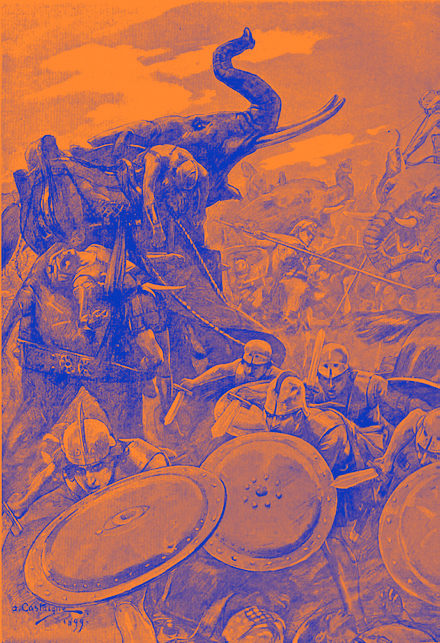
Indian Campaign
Forays into the Indian Subcontinent
After the death of Spitamenes and his marriage to Roxana (Raoxshna in Old Iranian) to cement relations with his new satrapies, Alexander turned to the Indian subcontinent. He invited the chieftains of the former satrapy of Gandhara (a region presently straddling eastern Afghanistan and northern Pakistan), to come to him and submit to his authority. Omphis (Indian name Ambhi), the ruler of Taxila, whose kingdom extended from the Indus to the Hydaspes (Jhelum), complied, but the chieftains of some hill clans, including the Aspasioi and Assakenoi sections of the Kambojas (known in Indian texts also as Ashvayanas and Ashvakayanas), refused to submit. Ambhi hastened to relieve Alexander of his apprehension and met him with valuable presents, placing himself and all his forces at his disposal. Alexander not only returned Ambhi his title and the gifts but he also presented him with a wardrobe of "Persian robes, gold and silver ornaments, 30 horses and 1,000 talents in gold". Alexander was emboldened to divide his forces, and Ambhi assisted Hephaestion and Perdiccas in constructing a bridge over the Indus where it bends at Hund, supplied their troops with provisions, and received Alexander himself, and his whole army, in his capital city of Taxila, with every demonstration of friendship and the most liberal hospitality.
On the subsequent advance of the Macedonian king, Taxiles accompanied him with a force of 5,000 men and took part in the battle of the Hydaspes River. After that victory he was sent by Alexander in pursuit of Porus, to whom he was charged to offer favourable terms, but narrowly escaped losing his life at the hands of his old enemy. Subsequently, however, the two rivals were reconciled by the personal mediation of Alexander; and Taxiles, after having contributed zealously to the equipment of the fleet on the Hydaspes, was entrusted by the king with the government of the whole territory between that river and the Indus. A considerable accession of power was granted him after the death of Philip, son of Machatas; and he was allowed to retain his authority at the death of Alexander himself (323 BC), as well as in the subsequent partition of the provinces at Triparadisus, 321 BC.
Revolt of the Army
East of Porus' kingdom, near the Ganges River, was the Nanda Empire of Magadha, and further east, the Gangaridai Empire of Bengal region of the Indian subcontinent. Fearing the prospect of facing other large armies and exhausted by years of campaigning, Alexander's army mutinied at the Hyphasis River (Beas), refusing to march farther east. This river thus marks the easternmost extent of Alexander's conquests.
As for the Macedonians, however, their struggle with Porus blunted their courage and stayed their further advance into India. For having had all they could do to repulse an enemy who mustered only twenty thousand infantry and two thousand horse, they violently opposed Alexander when he insisted on crossing the river Ganges also, the width of which, as they learned, was thirty-two furlongs, its depth a hundred fathoms, while its banks on the further side were covered with multitudes of men-at-arms and horsemen and elephants. For they were told that the kings of the Ganderites and Praesii were awaiting them with eighty thousand horsemen, two hundred thousand footmen, eight thousand chariots, and six thousand war elephants.
Alexander tried to persuade his soldiers to march farther, but his general Coenus pleaded with him to change his opinion and return; the men, he said, "longed to again see their parents, their wives and children, their homeland". Alexander eventually agreed and turned south, marching along the Indus. Along the way his army conquered the Malhi (in modern-day Multan) and other Indian tribes and Alexander sustained an injury during the siege.
Alexander sent much of his army to Carmania (modern southern Iran) with general Craterus, and commissioned a fleet to explore the Persian Gulf shore under his admiral Nearchus, while he led the rest back to Persia through the more difficult southern route along the Gedrosian Desert and Makran. Alexander reached Susa in 324 BC, but not before losing many men to the harsh desert.